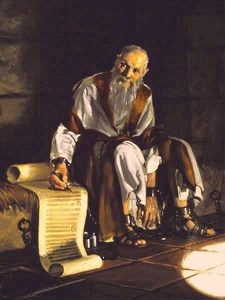
“I, Paul, write this greeting with my own hand, which is how I write in every letter.”
2 Thessalonians 3:17 NET
It’s well known that the apostle Paul wrote much of the New Testament. Thirteen books in all, in fact. But some argue that he really only wrote seven books, a.k.a. epistles or letters. Some even say three of them were somehow written after his death or forged (those to Timothy and Titus).
The discrepancy makes us wonder which letters Paul actually wrote. If there were only seven, where did the other six come from? Who wrote them? Are there any others?
It’s an amazing controversy, but the Bible defines who the true author is.
Saul to Paul?
Let’s begin with a fun fact about Paul.
Many people believe he changed his name from Saul to Paul after he accepted the Christian faith. According to Dr. Craig Keener, a professor of Biblical Studies at Asbury Theological Seminary, Paul already had the two names. He found it better to use his Roman name, Saul, because he was a Roman citizen, and he lived among them growing up.
He wouldn’t have used the Jewish version, Paulus or Paul, outside of Judea because the Greek interpretation of it had an offensive connotation. But, once he met Jesus on the road to Damascus and he found himself doing a lot of traveling around Judea, he often used Paul.
As Paul traveled, he commonly wrote letters to churches and private individuals. He wrote enough, in fact, that he surpasses Moses and the apostle John three times over.
The Thirteen Letters
Paul wrote thirteen letters during his Christian ministry: Romans, 1 and 2 Corinthians, Galatians, Ephesians, Philippians, Colossians, 1 and 2 Thessalonians, 1 and 2 Timothy, Titus, and Philemon.
Some people (like me for many years) want to attribute the book of Hebrews to Paul, but there is no evidence of this. It could have been written by any of his partners in ministry like Barnabas, Silas, Timothy, Luke, or several others.
One significant piece of evidence that Paul did not write Hebrews is that whoever did includes himself among those who say they received their confirmation of Jesus’ message from other people. Paul received his confirmation directly from the Lord Himself (Acts 91-9; Galatians 1:12), so Paul is instantly counted out as the author. Plus, Hebrews isn’t written in Paul’s typical structure (see below).
Three of his letters were Pastoral (personal) letters to dear friends—1 and 2 Timothy and Titus—while the remaining eleven were for general audiences. But not everyone agrees he wrote the Pastoral letters himself nor perhaps others.
Paul’s Critics
Modern critics believe Paul only wrote seven of the thirteen books: 1 Thessalonians, Galatians, 1 and 2 Corinthians, Philippians, Philemon, and Romans. Some believe his Pastoral letters plus his letter to the Ephesian church were forged. And, the critical jury is apparently still out on whether he actually wrote Colossians and 2 Thessalonians.
Still, other observers say there are lost letters that could be attributed to Paul.
One is thought to be a third letter to the church in Corinth. It’s called the Letter of Tears, and it refers to 2 Corinthians 2:4 and 7:8.
“For out of much affliction and anguish of heart I wrote to you, with many tears…” 2 Corinthians 2:4
“For even if I made you sorry with my letter, I do not regret it; though I did regret it.” 2 Corinthians 7:8
Another is a letter Paul apparently wrote earlier to the church in Ephesus, which we read in Ephesians 3:3.
“…how that by revelation He made known to me the mystery (as I have briefly written already, by which, when you read, you may understand my knowledge in the mystery of Christ) ….”
Finally, he evidently wrote a letter to the Laodiceans, which we see in Colossians 4:16.
“Now when this epistle is read among you, see that it is read also in the church of the Laodiceans, that you likewise read the epistle from Laodicea.”
Whether these letters exist, are lost to time, or were purposely left out of the Bible is unknown. But there appears to be some indication that Paul did write additional letters at some point.
The Critics’ Arguments
The critics’ arguments that someone else wrote Paul’s three Pastoral letters to Timothy and Titus are based on five main issues.
- Historical references in Paul’s letters are not consistent with the account of Paul’s life in the book of Acts.
- The false teaching described in his letters was a clear reflection of the Gnosticism of the second century.
- His descriptions of the church’s structure better describe the church of the second century and not of his time, the first century.
- His letters don’t contain the themes of his theology.
- The Greek vocabulary in his letters contains words not found in Paul’s other letters, nor in the rest of the New Testament.
These arguments are unequivocally and absolutely dismissed by theologians as we’ll see.
Theological Refute
Argument #1: The incompatibility of the timeline is because the narrative of Acts ends with Paul’s first imprisonment in Rome, not with his death. The argument could only be true if Paul was never released from jail, but we know he eventually was. He even knew he was going to be released (Philippians 1:19, 25-26; 2:24; Philemon 22), and his death did not occur for many years.
Argument #2: Theologians agree there are some similarities between Paul’s dissent in his three letters and second-century Gnosticism. However, unlike Gnosticism, false teachers, who based their teachings on Judaist legalism, were still in the church (Colossians 1:7; Titus 1:10,14; 3:9).
Argument #3: The church’s organizational structure is quite consistent with Paul’s writings such as in Acts 14:23 and Philippians 1:1.
Argument #4: Paul’s Pastoral letters do mention the central themes of his theology: the divine inspiration of Scripture (2 Timothy 3:115-17), election (2 Timothy 1:9; Titus 1:1-2), salvation (Titus 3:5-7), the deity of Christ (Titus 2:13), his personal calling by Jesus (Titus 2:5); and substitutionary punishment by Jesus for our sins (Titus 2:6).
Argument #5: The Greek vocabulary and subject matter were necessary because of the audience it was written for. The Pastoral letters were personal letters to Timothy and Titus, who were both Greek.

More Counterarguments
Theologians further point out…
- The early church never would have tolerated forged letters as part of Scripture.
- If they were forged, why weren’t the changes made so everything was consistent with Paul’s other writings?
- If the letters were written by dictation, does that still count Paul out as the original author?
- Finally, why would Paul warn us about deceivers (2 Timothy 3:13; Titus 1:10) if he was one himself? That doesn’t make sense. He would have blown his own cover, in a sense.
We can only conclude, then, that Paul’s three supposedly forged Pastoral letters were indeed written by him shortly after his release from his first Roman imprisonment. The only exception is 2 Timothy. That letter—his last letter—was written after his fifth and final missionary journey and during his second Roman imprisonment just before his martyred death in 67 A.D.
One interesting side note is that Jerusalem’s second temple (sometimes called Herod’s temple) was burned to the ground just three years after Paul’s death. The third temple won’t be built until the days when Jesus returns during Tribulation.
Authenticity of the Letters
All of Paul’s letters followed a similar pattern, which how we know if he is the actual author or not.
First, he always opened with a greeting where he included his name, and he called out the specific recipient.
“Paul, a bondservant of Jesus Christ…To all who are in Rome, beloved of God, called to be saints….” Romans 1:1, 7
“Paul, called to be an apostle of Jesus Christ…to the church of God which is at Corinth….” 1 Corinthians 1:1,2
“Paul, an apostle of Jesus Christ by the will of God…to the saints and faithful brethren in Christ who are in Colosse….” Colossians 1:1,2
He followed his greeting with the main body of his letter, then he had a formal farewell or blessing. Sometimes he included a greeting from whoever was with him.
“Greet every saint in Christ Jesus. The brethren who are with me greet you.” Philippians 4:23
“Greet all those who rule over you, and all the saints. Those from Italy greet you.” Hebrews 13:25
“Epaphras, my fellow prisoner in Christ Jesus, greets you, as do Mark, Aristarchus, Demas, Luke, my fellow laborers.” Philemon 25
All of Paul’s letters in the New Testament are structured this way, so we know he indeed wrote them all. None of them are forged.
And, we know he wrote many of his letters himself (see 1 Corinthians 16:21; Galatians 6:11; Colossians 4:18; 2 Thessalonians 3:17; Philmon 19). He may have dictated the others, which was a common practice at the time. Whether he dictated at all is unknown. Regardless, they would have been written according to his direction and supervision. As a highly trained former Pharisee, he would have been quite particular in making sure his letters were written just as he intended.
One True Author
As the main contributor to the New Testament, Paul has become the most influential Biblical figure aside from Jesus. His letters have touched lives and hearts and pointed many to salvation in Christ through his extraordinary words of wisdom.
Though some might question the authenticity of Paul’s letters, we can always be sure one undeniable truth. The Bible is the inspired work of the Holy Spirit. To Him alone deserves the credit for every single word.

Enjoyed reading, and thanks for visiting and sharing with Sunday Scripture Blessings. I had never pondered or read about discrepancies in Paul’s letters, but like the finishing statement that whomever wrote them…the Holy Spirit guided. Have a great week ahead. 🙂
Thanks so much for stopping by. God bless!
I enjoyed skimming through this, but I was wondering if could list your sources. I didn’t notice any hyperlinks or footnotes.
Three of my sources were Zondervan Academic, Huffington Post, and BibleStudy.org. Of course, my ultimate main source was the Bible itself. That is where I do most of my research. Thanks for reading, Lauren. God bless!
I’ve heard that argument too. The book could have been written by practically anyone. Still, you’re right. It was the Holy Spirit, ultimately. Thanks for reading, Aryn!
Fascinating! I didn’t realize there was that much debate over Paul’s letters!
I recently heard a very good argument that Priscilla might have written the Letter to the Hebrews. But regardless, We can be quite sure that God directed it!